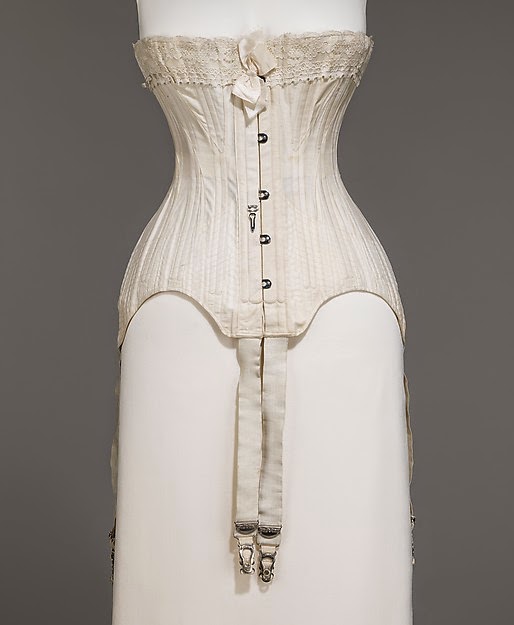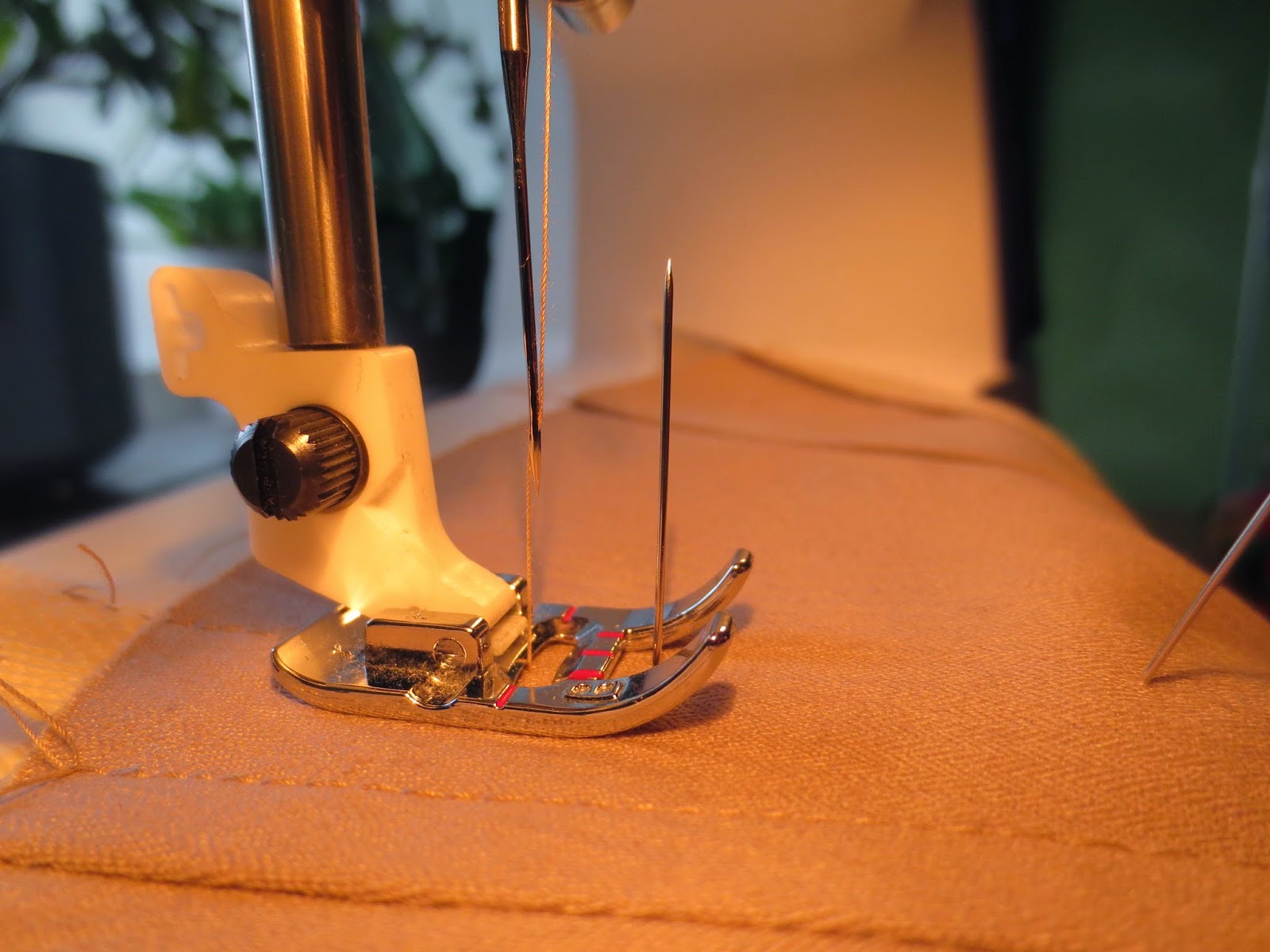So, what have I been making then? An edwardian corset using a pattern taken from a period original! I did have an edwardian corset from before, made up using Truly Victorians pattern TVE01, and I do love the look of it. The shape is however somewhat lacking in my opinion, the measurements are obviously adapted to our modern standard. It does provide some waist definition, but when applying a measuring tape the number it shows is almost bigger than my natural waist. Maybe it has to do with it being boned with flat steels only, I do not know.
Anyways, my fingers where itching for another project and I had been ogling the period patterns from Atelier Sylphe for quite some time, not being able to decide which one to pick. Then, Festive Attyre made a review for one of the patterns and I decided to be a copycat and buy the ref W pattern. I had been looking at it previously but been somewhat intimidated by the extreme hip-spring but theese fears were now pushed aside. The corset is listed as having a 21 inch waist which meant that it probably would fit me without any alterations (adding 2 inches for lacing gap and my natural waist is barely 25 inches). Some time ago in a discussion at the HSF facebook page, there was a discussion about the use of hip and bust pads to achieve the fashionable S-bend. Someone there purposed the theory that because many corsets of the time were sold off the rack in standard sizes most women would slip in a pad or two at various points to fill out the corset and its ideal S-curve. I do not have any references for this, but to me it sounds plausible. When looking at the pattern I therefor decided not to make any changes but instead pad away any fitting imperfections.
 |
| Ref W |
The reason that this corset went together so rapidly is that I did not make a mock-up for the pattern. I know, you always should, but I was fed up with mock-ups after the last corset and wanted to evaluate the original fit of the corset anyway. So I traced the seamlines, allowances and the placement of the bone casing onto the fabric and cut it all out. The corresponding seamlines were aligned on top of each other and the allowances flat felled according to the instructions provided with the pattern. Nothing to complain about really, it went together smoothly.
In the pictures of the original corsets the bone casings look like they are made from twill tape, fitting two bones under each strip of tape. Attaching bone casings has been a bit tricky for me in the past. I believe most corset makes agree when I argue that the seams are much prettier if stitched from the outside of the corset, but to do this the casings must be secured to the inside and the exact seamline visible from the outside. For my TVE01 i attempted to solve this by basting the casings on from the inside using a contrasting thread and using these basting stitches as a guide in the sewing machine. This did work acceptably, but there were some errors and if the sewing machine needle had gone through the basting the contrasting thread was a bitch to remove. So this time I developed my own method. It looks dangerous and potentially is, but it worked well for me. Should you attempt it, be careful and set the speed of your sewing machine to the lowest speed.
As said earlier, when I traced the pattern onto the fabric I took the time to include the bone casings. Now, with all of the pieces assembled, I filled them in with pencil and using flat headed pins went through the center of the twill tape strips first and then through the marked line on the corset. The pins were then pulled taut to really anchor the strips, as can be seen above. The pins were placed about an inch apart.
Close-up. Finished casings can be seen in the background.
What happened next was that I placed the corset in the sewing machine and using a longer stitch started making the seam, always aiming towards the next pin. The pins could of course not be sewn over, so before the presser foot reached the pin I stopped with the needle down, raised the foot and wriggled the pin out from the back. Then continue sewing and repeat.
Here you can see me moving the pin sideways and then pushing it back through the fabric. After that just reach under the fabric and pull it out. This technique was used for the middle of the three seams on each casing. The other two were sewn using only the presser foot as a guide.
The rest of the construction did not call for anything unusual. There are plenty of instructions for inserting a busk online and I used ordinary two-piece eyelets in the back. With my newly acquired tapered awl, also from SewCurvy, I could even insert them easily without punching holes through the fabric first. The lace along the top attached quite early so that I could set the eyelets on top of it.
Assembled and un-boned. The lace is from my mothers stash, probably used for curtains some time in the past
Boning is mostly spiral steel, even though the original used flat ones. I simply find the spiral ones more comfortable and easier to work with. The also enables more dramatic curves compared to modern flat steels. They were allegedly invented in 1904 by a Mr Beanman, but weather they were used widely from the start I know nothing of. The bones on either side of the eyelets are flat steel, as are the ones closest to the busk (I ran out of endcaps).
After all the bones went in it was time for binding. Inspired by Jill Salen's book "Corsets" I wanted to try using twill tape for binding, as is commonly done on antique corsets. I used the same twill tape as for the bone casings but tea-dyed it first (here is the tutorial I used, three bags of PG tips did the trick). I will definitely use twill tape for binding again, it was very easy to attach it and the result is very pretty.
Garters on this type of corset were generally covered or made from frilly elastics. I decided against covering because I could not decide what colour to use. Frilly elastic was on the other hand impossible to find in an appropriate colour. The dream would be to have garters as on this antique example (ebay wont let med copy the images, sorry). It is too bad that elastics or garter clips like that cannot be found anymore. I did however find two examples where very plain elastics were used:
 |
| The Met 2009.300.3124a, b |
 |
| The Met 2009.300.2759a–g |
The original ref W corset only had garters attached at the front, but I decided to put one on each side in order to prevent them standing away from my body like a weird pair of wings. I did not use any fancy method to attach them to the corset because I was in quite a hurry, they are just stitched on with the sewing machine.
Now for some pictures of the finished corset!
Next are pictures of the corset on my mannequin. It does not make it justice as it is somewhat larger than me and much less squishy.
 |
| Inside |
 |
| Outside |
 |
| Detail of boning channels. Flat felled seams visible behind. |
 |
| Eyelets inserted over lace. Tea-dyed twill tape binding |
 |
| Lace matched at center front. |
 |
| Garter. The white at the end barely shows when attached to stockings |
I will attempt to take some pictures of it on me and with proper padding underneath. Stay tuned!








































